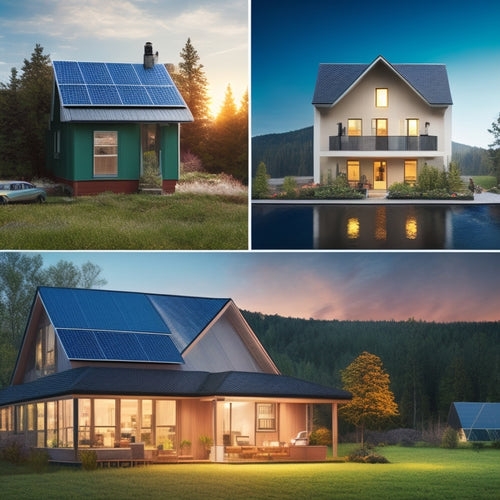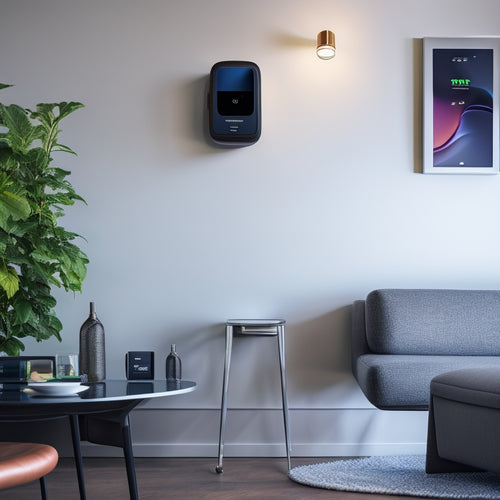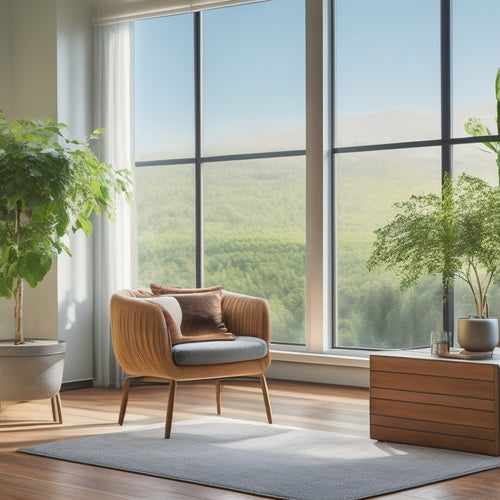
Cost-Effective Roofing: Savings Beyond Energy Bills
Share
You're likely aware that energy-efficient roofing can lead to significant cost savings on your energy bills, but what you may not know is that a cost-effective roofing system can also provide a multitude of benefits beyond energy savings. For instance, green roofing can increase property value, provide financial incentives, and even mitigate urban heat island effects. Reflective roofing systems and cool roof technologies can reduce energy consumption, while solar reflectance index benefits include decreased heat transfer and prolonged roof lifespans. By exploring the various aspects of cost-effective roofing, you'll uncover a wealth of opportunities to optimize your roofing investment and reap long-term benefits.
Key Takeaways
- Green roofing provides long-term benefits, including extended roof lifespan, reduced stormwater runoff, and increased property value, offsetting initial installation costs.
- Energy-efficient roofing solutions, such as reflective materials and cool roof technologies, reduce energy consumption and lower energy bills beyond electricity savings.
- High-solar-reflectance-index (SRI) materials decrease heat transfer into buildings, prolong roof lifespan, and increase energy production by cooling solar panels.
- Eco-friendly roof coatings, such as those with low VOC emissions and high solar reflectance, reduce urban heat island effects and minimize environmental impacts.
- Sustainable material sourcing practices, including locally sourced and recycled materials, reduce environmental impact and promote responsible building practices.
Green Roofing Cost-Benefit Analysis
When it comes to green roofing, one of the most important aspects to take into account is the cost-benefit analysis. You need to weigh the installation costs against the green roof benefits.
While the initial investment may seem steep, a well-designed green roof can provide significant returns. The installation costs, which range from $10 to $25 per square foot, can be offset by the extended lifespan of your roof, reduced stormwater runoff, and improved air quality.
Furthermore, green roofs can increase your property value and provide habitat for local wildlife. Additionally, integrating solar-powered charging solutions can further reduce energy costs and carbon footprint.
By leveraging green energy incentives, property owners can also benefit from tax credits and grants that help offset installation and maintenance costs.
Energy Savings Beyond Electricity
Beyond the obvious benefits of electricity savings, your green roof can also provide significant energy savings in other areas. For instance, it can reduce the load on your HVAC system by providing superior thermal performance, keeping your building cooler in the summer and warmer in the winter. Additionally, a well-designed green roof can reduce the energy required for moisture control by minimizing water infiltration and reducing the risk of mold and mildew.
| Energy Savings Area | Green Roof Benefit |
|---|---|
| HVAC Load Reduction | Superior thermal performance reduces heating and cooling needs |
| Moisture Control | Minimized water infiltration reduces energy required for dehumidification |
| Building Envelope Insulation | Additional insulation reduces heat loss and gain |
Cool Roof Technologies Explained
You're probably familiar with the concept of cool roofs, but do you know how they work?
Cool roof technologies are designed to reduce roof surface temperature, which is typically 10-20°F higher than ambient air temperature, by increasing solar reflectance index (SRI).
By mitigating the urban heat island effect, cool roofs can considerably reduce energy consumption and improve overall building performance.
Additionally, incorporating solar energy solutions can further reduce fossil fuel reliance and carbon footprint in buildings.
Roof Surface Temperature
As building owners and designers seek to reduce energy consumption and mitigate the urban heat island effect, they're turning to cool roof technologies that can considerably lower roof surface temperatures.
By adopting sustainable practices, such as those found in solar power solutions, they can also reduce their carbon footprint.
You'll want to understand the roof temperature impact on your building's overall energy efficiency. A thermal performance analysis will help you determine the effectiveness of a cool roof in reducing heat gain during summer and heat loss during winter.
By reducing the roof surface temperature, you'll decrease the amount of heat that's transferred into your building, resulting in lower energy bills.
With a cool roof, you can enjoy significant energy savings while also contributing to a more sustainable urban environment.
Solar Reflectance Index
Efficiency converges with innovation in the domain of cool roof technologies, where the Solar Reflectance Index (SRI) takes center stage.
You'll appreciate how SRI measures a roof's ability to reflect solar radiation and emit heat. This index calculates your roof's solar performance by combining its solar reflectance (the amount of sunlight it reflects) and thermal emittance (how well it releases heat).
By incorporating solar panels, you can generate clean, renewable energy essential for sustainable electrification renewable energy sources. A higher SRI means your roof is more energy-efficient and environmentally friendly.
When you choose reflective materials with high SRI values, you're investing in a cooler, more sustainable roof that reduces your energy bills and carbon footprint.
Urban Heat Island
High-performance cool roofs can mitigate a pervasive urban issue: the Urban Heat Island (UHI) effect. As you consider investing in a cool roof, you'll want to understand the impact of UHI on urban development and climate resilience. UHI occurs when built-up areas absorb and retain heat, causing temperatures to rise above those in surrounding rural areas. This can lead to heat-related illnesses, increased energy consumption, and compromised air quality.
| Urban Heat Island Impacts | Cool Roof Benefits | Community Effects |
|---|---|---|
| Increased energy consumption | Reduced energy demand | Lower energy costs |
| Heat-related illnesses | Improved air quality | Enhanced public health |
| Urban air pollution | Temperature regulation | Increased social equity |
| Compromised climate resilience | Improved urban planning | Sustainable urban development |
| Environmental degradation | Enhanced setting design | Mitigated environmental impact |
Solar Reflectance Index Benefits
By incorporating cool roofing materials with a high Solar Reflectance Index (SRI), you can greatly reduce the amount of heat that's transferred into your building. This not only reduces energy consumption but also prolongs the lifespan of your roof and its components, such as solar panels.
High-SRI materials are designed to reflect solar radiation, rather than absorb it, which reduces the temperature of your roof and the surrounding environment. When integrated with solar panel systems, these reflective materials can increase energy production by reducing the temperature of the panels.
Additionally, solar-powered EV chargers can also benefit from high-SRI materials, as they can optimize energy generation and reduce the strain on the grid. By choosing materials with high SRI values, you're investing in a cooler, more efficient, and more sustainable roofing system that gives you the freedom to focus on what matters most – your business or personal pursuits.
Roof Coatings for Energy Efficiency
As you investigate ways to maximize your roof's energy efficiency, consider the impact of roof coatings on your building's overall performance.
Energy efficient coatings can considerably reduce heat gain during summer months, decreasing the load on your cooling system. These coatings work by providing a reflective surface treatment that redirects solar radiation away from your building.
By applying a high-performance coating, you can increase your roof's solar reflectance, reducing the amount of heat that's absorbed. This results in lower energy bills and a more comfortable indoor environment.
Look for coatings with high total solar reflectance (TSR) values to guarantee peak energy efficiency. By investing in the right coating, you can enjoy long-term savings and a reduced carbon footprint.
Roof Insulation Cost Savings
Optimizing your roof's insulation is an important step in reducing energy consumption and costs. By choosing the right insulation materials and installation techniques, you can greatly lower your energy bills and enjoy a more comfortable living space.
| Insulation Materials | Installation Techniques |
|---|---|
| Fiberglass batts | Roll-out installation |
| Spray foam | Spray-and-stay installation |
| Radiant barrier | Staple-up installation |
| Reflective insulation | Retrofit installation |
| Cellulose insulation | Dense-pack installation |
When selecting insulation materials, consider factors like R-value, durability, and environmental impact. Proper installation techniques are also vital to guarantee ideal performance and longevity. By investing in quality insulation, you'll reap the benefits of reduced energy costs, increased comfort, and a more sustainable future.
Green Roofing Materials Options
You're likely considering eco-friendly roof coatings that reduce urban heat island effects and energy consumption.
You'll want to investigate sustainable material sourcing options, such as recycled materials, low-carbon concrete, and FSC-certified wood products.
Eco-Friendly Roof Coatings
With the growing emphasis on environmental sustainability, eco-friendly roof coatings have become an attractive option for building owners seeking to reduce their carbon footprint.
You'll find that these coatings not only minimize environmental impacts but also provide a cost-effective solution for extending the life of your roof.
When selecting an eco-friendly roof coating, consider the installation techniques used, as they can greatly impact the coating's effectiveness.
Look for coatings with low VOC (volatile organic compound) emissions, high solar reflectance, and recyclable materials.
Additionally, consider coatings with a long-lasting, waterproof barrier to minimize maintenance and repair costs.
Sustainable Material Sourcing
Sustainable building practices start from the ground up, literally, with the sourcing of green roofing materials that have a reduced environmental impact.
You can make a significant difference by choosing materials that are locally sourced, made from recycled materials, and have eco-friendly certifications.
When selecting materials, consider their durability and lifecycle assessment to guarantee they'll last long and reduce waste.
Look for suppliers with transparent sourcing practices and a green supply chain.
By doing so, you'll not only reduce your carbon footprint but also support sustainable practices throughout the entire production process.
This approach will give you peace of mind, knowing your roof isn't only cost-effective but also environmentally responsible.
Reflective Roofing System Advantages
Since buildings absorb a significant amount of heat through their roofs, a reflective roofing system can be a game-changing factor in reducing energy consumption.
By using reflective materials, you can minimize the amount of heat that's absorbed, which in turn reduces the load on your HVAC system. This leads to lower energy bills and a more comfortable indoor environment.
When it comes to installation techniques, it's crucial to verify a secure and even application of the reflective materials. This can be achieved through proper surface preparation, precise measurement, and careful handling of the materials.
Energy Star Rated Roofing Products
You can take your energy-efficient roofing efforts to the next level by specifying Energy Star rated roofing products.
These products meet strict energy efficiency guidelines set by the U.S. Environmental Protection Agency, ensuring they help reduce energy consumption and lower your energy bills.
When selecting Energy Star rated roofing materials, look for products with high solar reflectance and thermal emittance values.
These values indicate how well the material reflects sunlight and releases heat, reducing the amount of heat that's transferred into your building.
Long-Term Roofing Solution Benefits
By investing in a long-term roofing solution, you'll greatly reduce maintenance needs, freeing up resources for other priorities.
With a roof that's built to last, you can expect an extended lifespan, which means you won't need to worry about replacement costs for a long time.
In the long run, this translates to lower costs and fewer hassles for you.
Reduced Maintenance Needs
Across the lifespan of a roofing system, maintenance costs can add up quickly, but a well-designed, long-term roofing solution helps mitigate this financial burden by reducing the frequency and scope of necessary repairs and upkeep. By investing in a high-quality roofing system, you'll benefit from reduced maintenance needs, freeing up your time and resources for more important things.
| Traditional Roofing | Long-Term Roofing Solution |
|---|---|
| Frequent roof inspections (every 6-12 months) | Infrequent roof inspections (every 2-3 years) |
| Complex maintenance schedules | Simplified maintenance schedules |
| Higher repair costs | Lower repair costs |
| Increased risk of water damage | Decreased risk of water damage |
| More frequent replacements | Less frequent replacements |
Extended Roof Lifespan
A well-maintained roofing system is only as good as its ability to withstand the test of time, and a long-term roofing solution takes this concept to the next level.
You get to enjoy a roof that lasts longer, thanks to durability factors like weather resistance and material longevity. Proper installation techniques also play an essential role in extending your roof's lifespan.
By choosing a roof with a long lifespan, you're reducing your environmental impact and creating a sustainable solution. Plus, a long-lasting roof means you can enjoy its aesthetic appeal for years to come.
Look for warranty options that back up the manufacturer's claims, giving you peace of mind and protection from costly repairs.
With regular roof maintenance, you can maximize your roof's potential and reap the benefits of a long-term roofing solution.
Lower Replacement Costs
Take a step back and reflect on the long-term implications of your roofing solution: with a long-lasting roof, you'll greatly slash replacement costs down the line.
By investing in affordable materials and proper installation techniques, you'll reduce the need for frequent replacements. This means you can allocate your budget to other essential expenses, enjoying more financial freedom.
Here are some key factors to contemplate for lower replacement costs:
- Thorough contractor selection to guarantee a durable roof installation
- Warranty options that provide long-term protection
- Cost analysis to identify the most cost-effective solutions
- Budget planning for maintenance and potential repairs
Frequently Asked Questions
Can I Install a Cool Roof Over an Existing Traditional Roofing System?
You can install a cool roof over an existing traditional roofing system, but you'll need to guarantee the underlying structure can support the added weight and consider potential moisture issues before proceeding with the cool roof installation.
Are Energy-Efficient Roofing Materials More Prone to Damage?
You wonder if energy-efficient roofing materials are more prone to damage, and rightly so, as durability concerns arise; however, most modern materials boast impressive material lifespan, with some lasting up to 50 years or more with proper installation and maintenance.
Do Green Roofs Require More Frequent Maintenance Than Traditional Roofs?
You'll find that green roofs typically require more frequent maintenance than traditional roofs, but with proper maintenance tips, like regular inspections and watering, you can reap the benefits of a green roof, including improved air quality and increased property value.
Can I Install a Green Roof on a Residential Building With a Flat Roof?
Imagine a tranquil oasis above your home! Yes, you can install a green roof on a residential flat roof, but be prepared to tackle unique installation challenges, assessing the benefits of increased biodiversity against potential structural demands.
Are Energy-Efficient Roofing Materials Compatible With All Building Types?
When selecting energy-efficient roofing materials, you'll need to take into account building regulations and material compatibility, ensuring the chosen material meets local codes and works seamlessly with your building's structure, regardless of its type or age.
Related Posts
-

What Does Your Home Energy Audit Report Reveal?
Your home energy audit report reveals a detailed analysis of your energy consumption patterns, highlighting areas of ...
-

7 Best EV Battery Health Trackers for Homeowners
You can maximize your electric vehicle's performance and lifespan by leveraging advanced battery health trackers that...
-

7 Smart Air Purification Hacks for Energy-Savvy Homes
You can notably improve your indoor air quality while minimizing energy consumption by implementing strategic air pur...


